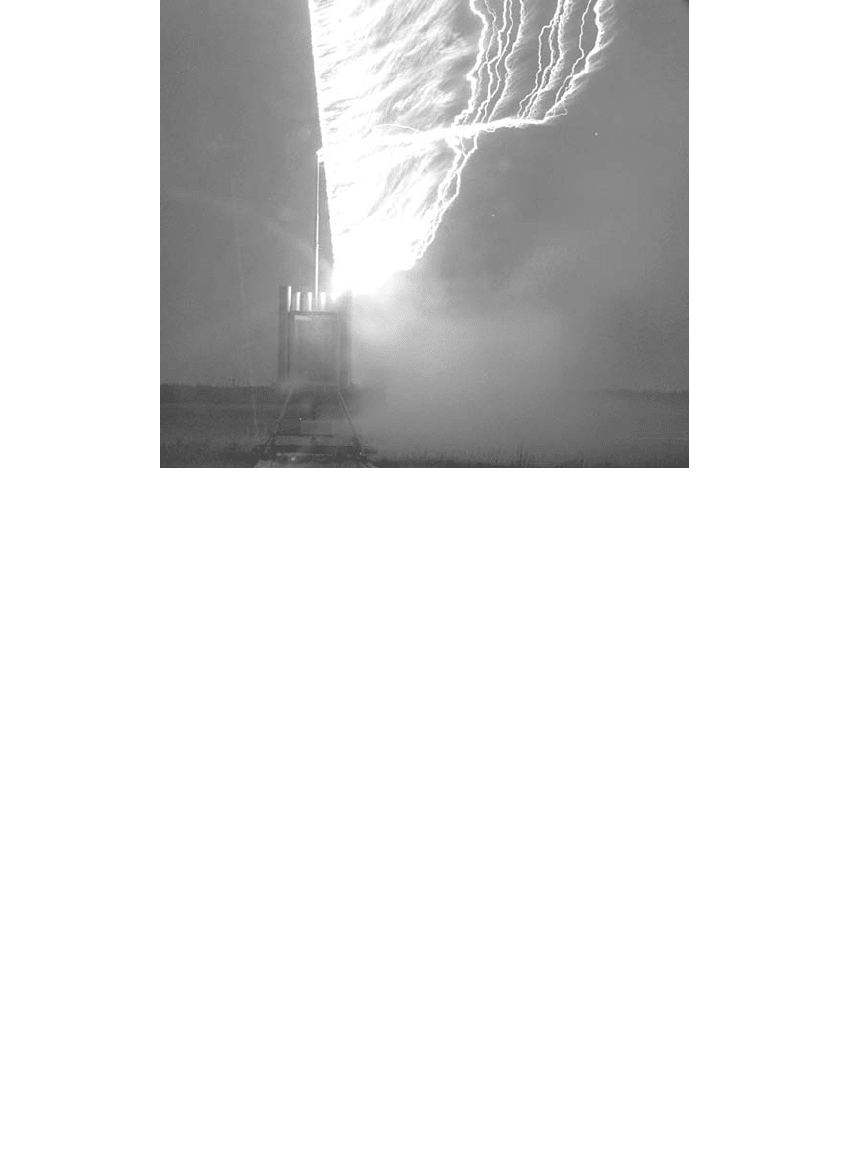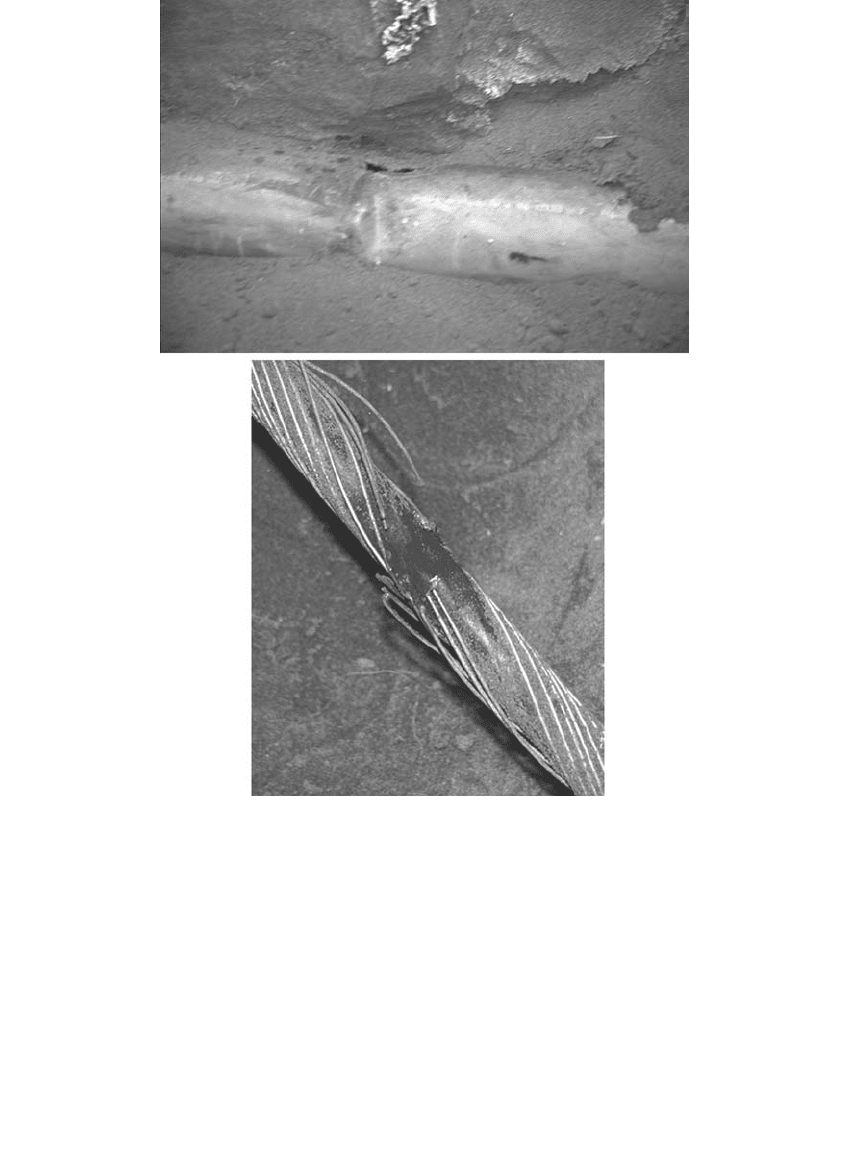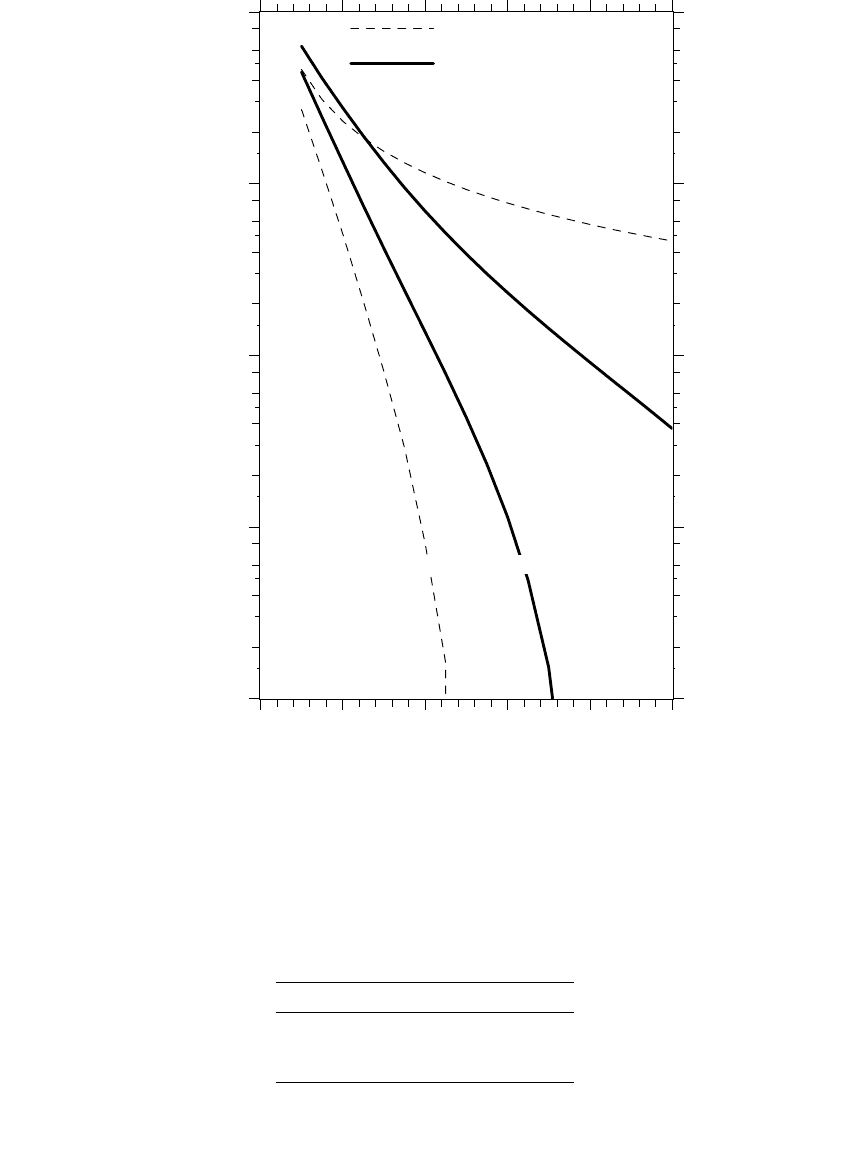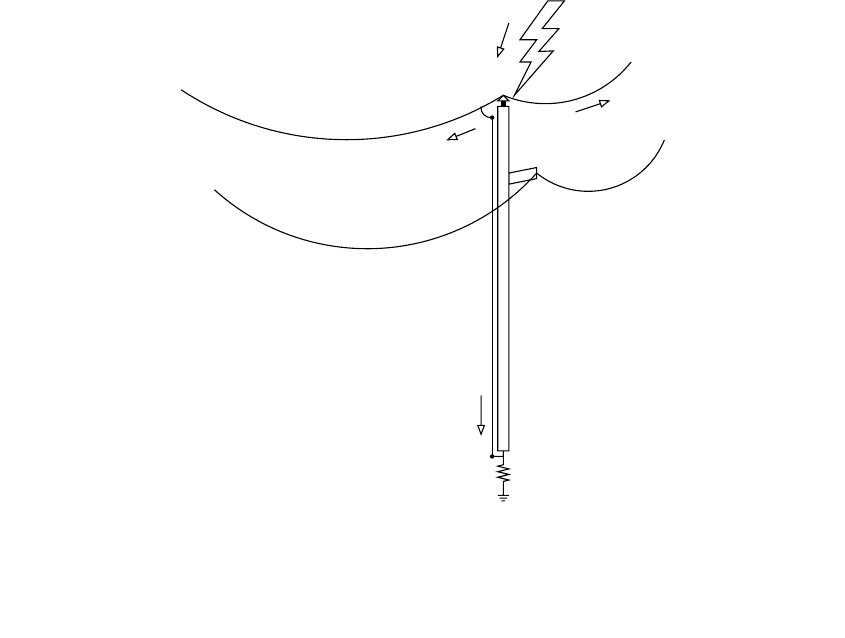Short T.A. Electric Power Distribution Handbook
Подождите немного. Документ загружается.


628 Electric Power Distribution Handbook
12.6.4 Other Cable Failure Modes
Lightning may also puncture the jackets in jacketed cable. Ros (1993) dem-
onstrated that lightning current into a riser-pole ground created enough
ground potential rise to puncture jackets and leave pin holes. Fifty-mil jackets
punctured with 150 to 160 kV, and 80-mil jackets punctured with 155 to 170
kV. The voltage impressed across the cable jacket is the surge current times
the ground resistance at the riser pole, which may be very high with poor
grounds. Ros’ tests found semiconducting jackets did not allow nearly the
voltage to develop across the jacket.
Lightning can also damage cables from strikes above the ground. EPRI
tests found that rocket-triggered lightning strikes to the ground above buried
cables caused extensive damage (Barker and Short, 1996). Lightning nor-
mally breaks down the soil and arcs to the cable (see Figure 12.22 and Figure
12.23). We tested three cable configurations: unjacketed direct buried, jack-
eted direct buried, and jacketed cable in conduit. All were single-conductor
220-mil XLPE cables with a full copper neutral. Lightning above the ground
damaged them all to varying degrees. Lightning melted most strands of the
concentric neutral and punctured the jacket and conduit if present. In some
cases, lightning also damaged the insulation shield. What made the damage
particularly bad was that lightning hit the soil surface and continued an
arcing path 3 ft (1 m) underground directly to the cable. Measurements
FIGURE 12.22
Lightning flash triggered by a rocket trailing a wire. (Copyright © 1993. Electric Power Research
Institute. Reprinted with permission.)
1791_book.fm Page 628 Monday, August 4, 2003 3:20 PM
(C) 2004 by CRC Press LLC

Lightning Protection 629
showed that 15 to 25% of the lightning currents reached the padmounted
transformers on either side of the flash point. This type of cable damage
would not show up immediately. More likely, cable failure would accelerate
from increased water entry and localized neutral heating. Voltages we mea-
sured across the cable insulation were not a significant threat (they were less
than 17 kV).
The tests also pointed to secondary voltages as a concern. We found nearly
4 kV on the closest transformer secondary. Surge entry into the secondary
FIGURE 12.23
Cable and conduit damage observed from rocket-triggered lightning flashes above the ground.
(Copyright © 1993. Electric Power Research Institute. Reprinted with permission.)
1791_book.fm Page 629 Monday, August 4, 2003 3:20 PM
(C) 2004 by CRC Press LLC

630 Electric Power Distribution Handbook
stresses the transformer insulation and sends possibly damaging surges into
homes. Current entering into the secondary neutral terminal of the trans-
former induces voltages that stress the primary winding. Williams (1988)
presented evidence that padmounted transformers fail from secondary-side
surge entry in similar percentages to overhead transformers.
During the rocket-triggered lightning tests, strokes to the cable attached
from as far away as 15 ft (5 m). Furrows from trees to underground cables
as long as 300 ft (100 m) have been found (Sunde, 1968). Sunde derived a
model for lightning attraction to buried cables based on the lightning current
and the soil resistivity. The number of flashes attracted to cables depends on
flash density, the peak current magnitude, and the ground resistivity. Higher
peak lightning currents make longer jumps to cables. Cables in higher-
resistivity soil attract flashes from farther away. The Sunde model predicts
that cables attract strikes within the following radius:
where
r = attractive radius, m
r = soil resistivity, W-m
I
p
= peak lightning current, kA
Using the IEEE distribution of peak first strokes, this gives the following
collection rates to cables:
for N in flashes/100 km/year (multiply by 1.609 for results in flashes/100
mi/year) and N
g
in flashes/km
2
/year. For resistivities in the region that
Sunde left out (100 to 1000 W◊m), either interpolate the results from each
equation or use the closest equation. For 1000 W◊m soil with N
g
= 1, cables
attract 2.7 flashes/100 mi/year (1.7 flashes/100 km/year). For areas in trees,
cables collect more flashes; EPRI (1999) recommends doubling the number
of strikes for areas in trees.
These flashes to cables puncture jackets and conduits. The amount of
heating damage to the neutral and to the insulation is primarily a function
of the total charge in the lightning flash (since arcs exhibit a fairly constant
voltage drop at the point of attachment, the energy is a function of ÚIdt).
Burying shield wires above the cables is one way to offer protection against
this type of damage. An AT&T handbook (1985) provides estimates on shield-
wire effectiveness. Note that there is no current power industry practice for
r
I
I
p
p
=
◊£◊
◊≥◊
Ï
Ì
Ô
Ó
Ô
0 079
0 046
.
.
rr
rr
100 m
1000 m
W
W
N
N
N
g
g
=
£◊
≥◊
Ï
Ì
Ô
Ó
Ô
0 092
0 053
.
.
rr
rr
100 m
1000 m
W
W
1791_book.fm Page 630 Monday, August 4, 2003 3:20 PM
(C) 2004 by CRC Press LLC

Lightning Protection 631
this type of protection, and the amount of damage (percent of cable faults)
is unknown.
12.7 Line Protection
Line protection is the attempt to reduce the number of lightning-caused
faults. Utilities have increased interest in line protection as one way to
improve reliability and power quality. Since lightning can flash over a 230-
kV or 500-kV transmission line, we should not be surprised that protecting
a 13-kV distribution line is difficult. To protect against direct hits, we need
either a shield wire or arresters to divert the stroke to ground without a
flashover. Lightning strokes close to a line may induce enough voltage to
flash over the line insulation. Induced voltages are easier to contain since
induced voltages have much lower magnitudes than direct strike voltages.
Maintaining enough insulation capability is the normal way to limit induced-
voltage flashovers. Line arresters can also greatly reduce induced voltage
flashovers from nearby strokes.
12.7.1 Induced Voltages
Lightning strikes near a distribution line will induce voltages into the line
from the electric and magnetic fields produced by the lightning stroke. These
induced voltages are much less severe than direct strikes, but close strikes
can induce enough voltage to flash insulation and damage poorly protected
equipment.
The charge and current flow through the lightning channel creates fields
near the line. These fields induce voltages on the line. The vertical electric
field is the major component that couples voltages into the line (magnetic
fields also play a role). As the highly charged leader approaches the ground,
the electric field increases greatly; and when the leader connects, the electric
field collapses very quickly. The rapidly changing vertical electric field
induces a voltage on a conductor, which is proportional to the height of the
conductor above ground. The induced voltage waveform is usually a narrow
pulse, less than 5 or 10 msec wide, and it may be bipolar (negative then
positive polarity).
Most measurements of induced voltages have been less than 300 kV, so
the most common guideline for eliminating problems with induced voltages
is to make sure that the line insulation capability (CFO) is higher than 300
kV. Lines with insulation capabilities less than 150 kV have many more
flashovers due to induced voltages.
A simplified version of a model developed by Rusck (1958, 1977) approx-
imates the peak voltage induced by nearby lightning. Rusck’s model can be
1791_book.fm Page 631 Monday, August 4, 2003 3:20 PM
(C) 2004 by CRC Press LLC

632 Electric Power Distribution Handbook
simplified to estimate the peak voltage developed on a conductor (IEEE Std.
1410-1997):
where
V = peak induced voltage, kV
I = peak stroke current, kA
h = height of the line, usually ft or m
y = distance of the stroke from the line
This equation is for an ungrounded circuit. For a circuit with a grounded
neutral or shield wire, the voltage from the phase to the neutral is less. For
normal distribution line conductor spacings, multiply the answer by 0.75 for
lines with a grounded neutral. So, for a 30-ft (10-m) distribution line, a 40-
kA stroke 200 ft (60 m) from the line induces 165 kV on a line with a grounded
neutral. Most lines are immune from strikes farther than 500 ft (150 m) from
the line.
Models of attraction to distribution lines show that for lines out in the
open, most flashes that do not hit the line are too far away to induce a
particularly high voltage across the insulation. For environmentally shielded
lines — those with nearby trees and buildings — fewer strikes hit the line,
but the line should have higher induced voltages because lightning strokes
could hit closer to the line.
EPRI sponsored rocket triggered lightning tests in 1993 that showed
induced voltages could be higher than predicted by Rusck’s model for some
strikes (Barker et al., 1996). For strikes to the ground 475 ft (145 m) from the
line, voltages were 63% higher than Rusck’s model. Hydro Quebec and New
York State Electric and Gas sponsored another round of tests in 1994 that
were also led by P. P. Barker. Closer strokes, strokes 60 ft (18 m) from the
line, induced less voltage than the Rusck model.
Table 12.14 compares the rocket-triggered lightning measurements with the
Rusck model. High ground resistivity at the Florida test site probably explains
why the 475-ft (145-m) measurements were higher than the Rusck prediction
(Ishii, 1996; Ishii et al., 1994). Why the closer measurements are lower is not
TABLE 12.14
Comparison of Induced Voltage Measurements to Rusck Predictions
Distance
Number of
Data Samples
Rusck Prediction
V
ind
/I
s
Rocket-Triggered
Lightning Measurements
V
ind
/I
s
60 ft (18 m) 20 12.2 5.25
400 ft (125 m) 8 1.7 2.67
475 ft (145 m) 63 1.4 2.24
V = .
Ih
y
36 5
◊
1791_book.fm Page 632 Monday, August 4, 2003 3:20 PM
(C) 2004 by CRC Press LLC

Lightning Protection 633
verified. My best guess is because those strokes were triggered from rockets
launched on a 45-ft (14-m) tower. Since the tower is above ground, the positive
charge on the tower shields some of the negative charge in the downward
leader, so the electric field inducing voltages into the line is smaller. Environ-
mentally shielded lines should act similarly to the tall tower. The charge
collected on the tree should shield the line and reduce the induced voltage.
The three induced-voltage data points when normalized for a 30-ft (10-m)
tall distribution line fit the following equation:
Figure 12.24 shows estimates of induced voltages with insulation level for
both open ground and for lines that are environmentally shielded (usually
by trees). One is based on Rusck’s model using the approach from IEEE Std.
1410-1997. Another is based on the curve fit of the triggered lightning results,
which shows more reasonable answers for environmentally shielded lines.
12.7.2 Insulation
High insulation levels on structures help prevent induced voltage flashovers.
Insulation levels are also critical on some types of line protection configura-
tions with shield wires or arresters. Note that for a normal distribution line,
higher insulation levels may actually stress nearby cables and transformers
more. With high insulation strengths, a higher voltage develops across the
insulation before it flashes over. By allowing a larger magnitude surge on
the line before flashover, damage to nearby equipment is more likely. The
flashover of the insulation acts as an arrester and protects other equipment.
The critical flashover voltage (CFO) of self-restoring insulation (meaning
no damage after a flashover) is the voltage where the insulation has a 50%
probability of flashing over for a standard 1.2/50-msec voltage wave. For
insulators, manufacturers’ catalogs specify the CFO. CFO and BIL are often
used interchangeably, but they have slightly different definitions. A statistical
BIL is the 10% probability of flashing over for a standard test wave. Normally,
CFO and statistical BIL are within a few percent of each other.
Lightning may flash along several paths: directly between conductors
across an air gap or along the surface of insulators and other hardware at
poles (normally the easiest path to flashover). We need to consider phase-
to-ground and phase-to-phase paths. At a pole structure, the flashover path
may involve several insulating components, the insulator, wood pole or
crossarm, and possibly fiberglass. Wood and fiberglass greatly increase the
structure insulation.
Table 12.15 shows the critical flashover voltage of common components.
When more than one insulator is in series, the total insulating capability is
V =
I
y
98
1
121
18
.
.
+
Ê
Ë
Á
ˆ
¯
˜
1791_book.fm Page 633 Monday, August 4, 2003 3:20 PM
(C) 2004 by CRC Press LLC

634 Electric Power Distribution Handbook
FIGURE 12.24
Induced voltage flashovers vs. insulation level for a line with a grounded neutral.
TABLE 12.15
CFO of Common Distribution
Components (By Themselves)
Component kV/ft kV/m
Air 180 600
Wood pole or crossarm 100 350
Fiberglass standoff 150 500
Shielded lines
Lines in the open
Rusck model
Rocket-triggered model
0 100 200 300 400 500
0.01
0.1
1.0
10.0
100.0
CFO, kV
Flashovers/100 miles/year
for N
g
=1 flash/km
2
/year
1791_book.fm Page 634 Monday, August 4, 2003 3:20 PM
(C) 2004 by CRC Press LLC

Lightning Protection 635
less than the sum of the components. When insulation is subjected to a
voltage surge, the voltage across each component splits based on the capac-
itance between each element. Normally, this voltage division does not split
the voltage by the same ratio as their insulation capability, so one component
flashes first leaving more voltage across the rest of the components.
The simplest way to estimate the insulation level of a structure is to take
the CFO of the insulator (usually about 100 kV) and add the wood length at
75 kV/ft (250 kV/m). Often the wood provides more insulation than the
insulator. Estimate the air-to-air gap using 180 kV/ft (600 kV/m). The air gap
between conductors usually has higher insulation than the path along the
insulator and wood. So, most flashovers occur at the poles, the weakest point.
Typical distribution structures generally have CFOs between 150 and 300 kV.
And, to eliminate induced voltage flashovers, we try to have 300 kV of CFO.
Another way to estimate the structure CFO of several components in series
is to take the square root of the sum of the squares of each component.
Another more precise way to estimate structure CFOs is with the extended
CFO added method described by Jacob et al. (1991) and Ross and Grzy-
bowski (1991) (or, see IEEE Std. 1410-1997 for a simplified version).
12.7.2.1 Practical Considerations*
Equipment and support hardware on distribution structures may severely
reduce CFO. These “weak-link” structures may greatly increase flashovers
from induced voltages. Several situations are described below.
Guy wires. Guy wires may be a major factor in reducing a structure’s CFO.
For mechanical advantage, guy wires are generally attached high on the pole
in the general vicinity of the principal insulating elements. Because guy wires
provide a path to the ground, their presence will generally reduce the con-
figuration’s CFO. The small porcelain guy-strain insulators that are often
used provide very little in the way of extra insulation (generally less than
30 kV of the CFO).
A fiberglass-strain insulator may be used to gain considerable insulation
strength. A 20-in. (50-cm) fiberglass-strain insulator has a CFO of approxi-
mately 250 kV.
Fuse cut-outs. The mounting of fuse cut-outs is a prime example of unpro-
tected equipment which may lower a pole’s CFO. For 15-kV class systems,
a fuse cut-out may have a 95-kV BIL. Depending on how the cut-out is
mounted, it may reduce the CFO of the entire structure to approximately 95
kV (approximately because the BIL of any insulating system is always less
than the CFO of that system).
On wooden poles, the problem of fuse cut-outs may usually be improved
by arranging the cut-out so that the attachment bracket is mounted on the
pole away from any grounded conductors (guy wires, ground wires, and
* This section is from IEEE Std. 1410-1997. Copyright 1997. All rights reserved. The author
chaired the IEEE working group on the Lightning Performance of Distribution Lines during the
development and approval of this guide.
1791_book.fm Page 635 Monday, August 4, 2003 3:20 PM
(C) 2004 by CRC Press LLC

636 Electric Power Distribution Handbook
neutral wires). This is also a concern for switches and other pieces of equip-
ment not protected by arresters.
Neutral wire height. On any given line, the neutral wire height may vary
depending on equipment connected. On wooden poles, the closer the neutral
wire is to the phase wires, the lower the CFO.
Conducting supports and structures. The use of concrete and steel structures
on overhead distribution lines is increasing, which greatly reduces the CFO.
Metal crossarms and metal hardware are also being used on wooden pole
structures. If such hardware is grounded, the effect may be the same as that
of an all-metal structure. On such structures, the total CFO is supplied by
the insulator, and higher CFO insulators should be used to compensate for
the loss of wooden insulation. Obviously, trade-offs should be made between
lightning performance and other considerations such as mechanical design
or economics. It is important to realize that trade-offs exist. The designer
should be aware of the negative effects that metal hardware may have on
lightning performance and attempt to minimize those effects. On wooden
pole and crossarm designs, wooden or fiberglass brackets may be used to
maintain good insulation levels.
Multiple circuits. Multiple circuits on a pole often cause reduced insulation.
Tighter phase clearances and less wood in series usually reduces insulation
levels. This is especially true for distribution circuits built underneath trans-
mission circuits on wooden poles. Transmission circuits will often have a
shield wire with a ground lead at each pole. The ground lead may cause
reduced insulation. This may be improved by moving the ground lead away
from the pole with fiberglass spacers.
Spacer-cable circuits. Spacer-cable circuits are overhead-distribution circuits
with very close spacings. Covered wire and spacers [6 to 15 in. (15 to 40 cm)]
hung from a messenger wire provide support and insulating capability. A
spacer-cable configuration will have a fixed CFO, generally in the range of
150 to 200 kV. Because of its relatively low insulation level, its lightning
performance may be lower than a more traditional open design (Powell et
al., 1965). There is little that can be done to increase the CFO of a spacer-
cable design.
A spacer-cable design has the advantage of a messenger wire which acts
as a shield wire. This may reduce some direct-stroke flashovers. Back flash-
overs will likely occur because of the low insulation level. Improved ground-
ing will improve lightning performance.
Spark gaps and insulator bonding. Bonding of insulators is sometimes done
to prevent lightning-caused damage to wooden poles or crossarms, or it is
done to prevent pole-top fires. Spark gaps are also used to prevent lightning
damage to wooden material [this includes Rural Electrification Administra-
tion specified pole-protection assemblies (REA Bulletin 50-3, 1983)]. In some
parts of the world, spark gaps are also used instead of arresters for equip-
ment protection.
Spark gaps and insulator bonds will greatly reduce a structure’s CFO. If
possible, spark gaps, insulator bonds, and pole-protection assemblies should
1791_book.fm Page 636 Monday, August 4, 2003 3:20 PM
(C) 2004 by CRC Press LLC

Lightning Protection 637
not be used to prevent wood damage. Better solutions for damage to wood
and pole fires are local insulator-wood bonds at the base of the insulator.
12.7.3 Shield Wires
Shield wires are effective for transmission lines but are difficult to make
work for distribution lines. A shield wire system works by intercepting all
lightning strokes and providing a path to ground. If the path to ground is
not good enough, a voltage develops on the ground with respect to the
phases (called a ground potential rise). If this is high enough, the phase can
flashover (it is called a backflashover).
Grounding and insulation are important. Good grounding reduces the
ground potential rise. Extra insulation protects against backflashover. As an
example, consider Figure 12.25 where a 22-kA stroke (which is on the small
size for lightning) is hitting a distribution line. The ground potential rises to
400 kV relative to the phase conductor, enough voltage to flashover most
distribution lines.
To keep the insulation high, use fiberglass standoffs to keep the ground
wire away from the pole to maximize the wood length. Also, make sure guy
wires and other hardware do not compromise insulation.
FIGURE 12.25
Shield-wire lightning protection system.
Phase wire
Shield wire
1 kA
1 kA
20 ohms
20 kA
= 20 kA(20 ohms)
= 400 kV
V
22 kA
1791_book.fm Page 637 Monday, August 4, 2003 3:20 PM
(C) 2004 by CRC Press LLC
